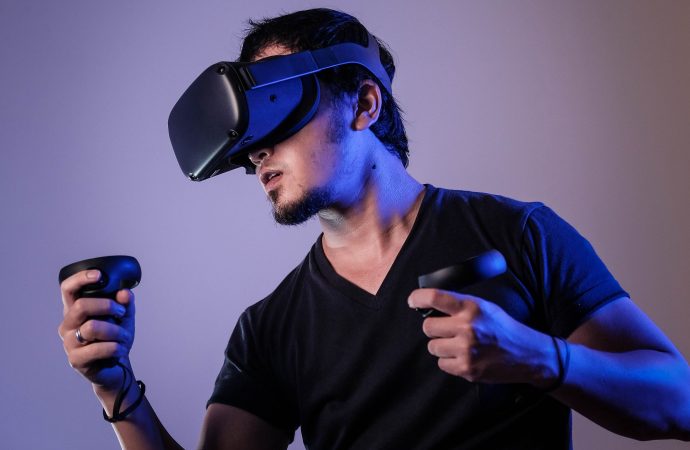Are you ready to step into the future of education? Virtual reality technology is revolutionizing the way we learn, and it’s only getting better. From immersive field trips to interactive simulations, virtual reality offers endless possibilities for enhancing student engagement and understanding. In this blog post, we’ll explore the potential of virtual reality in education
Are you ready to step into the future of education? Virtual reality technology is revolutionizing the way we learn, and it’s only getting better. From immersive field trips to interactive simulations, virtual reality offers endless possibilities for enhancing student engagement and understanding. In this blog post, we’ll explore the potential of virtual reality in education and how it’s changing the face of learning in the USA. Let’s dive in!
The History of Virtual Reality
Virtual reality (VR) has been around for a while, but it has only recently started to become popular in Education.
There are a few reasons why VR is becoming more popular in Education. One reason is that VR allows students to explore new environments and learn about different subjects without having to leave their homes. Additionally, VR can help students learn math and science concepts in a more engaging way.
The benefits of using VR in Education are clear, but there are also some challenges that need to be addressed first. For example, many schools don’t have the resources necessary to install and use VR systems. Additionally, some teachers worry that using VR might distract students from their actual classroom learning. However, with careful planning and implementation, VR can be an extremely powerful tool for Teaching and Learning.
What are the Benefits of Virtual Reality?
Virtual reality is a technology that enables people to experience a simulated environment that is different from their everyday reality. This technology has many potential benefits for education, including: creating immersive learning environments for students; providing individualized learning experiences for all students; and creating new ways of teaching andlearning.
Immersive learning environments are essential for engaging students in the learning process. Virtual reality can create immersive environments that provide an accurate representation of real-world scenarios, allowing students to learn more effectively. Individualized learning experiences enable students to tailor their learning experience to their own preferences and needs. Virtual reality can also be used to simulate physical challenges that are difficult or impossible to experience in the traditional classroom setting, such as flying in space or exploring the inside of a volcano.
Another benefit of virtual reality is its potential use in teaching new skills. Immersive VR training programs can help employees learn how to do specific tasks quickly and efficiently. Training programs using virtual reality can also be customized to match the needs of individual employees, making it easier for them to learn what they need to know without struggling with unnecessary extraneous content.
Overall, virtual reality has many potential benefits for education. It can help students learn more effectively by providing immersive learning environments and individualized experiences. It can also be used to teach new skills quickly and efficiently, making it an ideal tool for training employees
How is Virtual Reality Used in Education?
Virtual Reality is being used more and more in education, as it offers a new way to experience and learn. It can be used for a wide range of subjects, from history to science. Virtual Reality can also be used to help students with disabilities or autism spectrum disorders feel more confident and connected when participating in class.
One of the most popular uses of virtual reality in education is for history.Using VR headsets, students can explore important historical sites like Gettysburg or the Battle of Waterloo. This can help students better understand the events that took place and give them a new perspective on them. VR also allows teachers to create simulations that are completely unique to their classroom, which can help engage students even more.
Science has also been widely adopted by schools using virtual reality technology.This is because VR allows students to experience experiments and activities in a new way that is both informative and fun. For example, one school used VR technology to teach children about different weather patterns around the world.
Another great use of virtual reality in education is for simulations that focus on disabilities or autism spectrum disorders. These simulations allow students who might not be able to attend real-life classes or participate in traditional educational activities, to still receive an education. For example, one school created a simulation where students could experience what it feels like to have cerebral palsy. This allowed many children who would not otherwise have had the opportunity to participate in classes, to learn about these issues firsthand
The Future of Virtual Reality in Education
Virtual reality has the potential to revolutionize education by providing a new way for students to learn. It allows them to experience information in a completely new way, making it easier for them to remember and apply what they have learned. In addition, it can also help students who have difficulty participating in traditional classes due to physical or mental disabilities.
There are many potential applications for virtual reality in education, and the possibilities are only limited by our imagination. Here are just a few:
1. Training and simulation: Virtual reality can be used to train professionals in various fields, such as medicine, law enforcement, and engineering. It can also be used for simulated training situations, such as when teaching pilots how to fly using 3D simulations.
2. Learning modules: Virtual reality can be used to create learning modules that allow students to explore different topics in depth. For example, you could create a virtual environment that simulates an archaeological dig, so students can learn about ancient civilizations from inside the ground!
3. Immersive learning: VR allows us to immerse ourselves in new environments and experiences like never before. This is especially useful for teaching subjects that require hands-on experience, such as chemistry or physics.
4. Distance learning: If you don’t have any physical classrooms available or if your students live too far away from yours, VR can still be of use! You could create VR content that teaches specific subjects remotely – either on your own





















Leave a Comment
Your email address will not be published. Required fields are marked with *